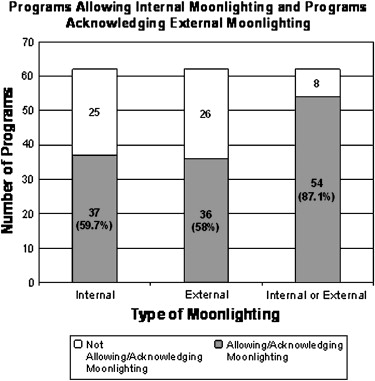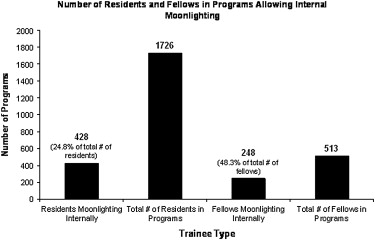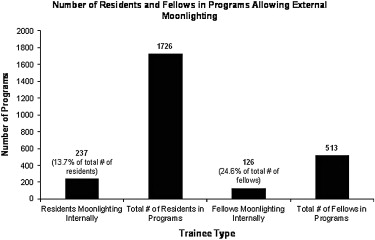Rationale and Objectives
Time devoted to internal moonlighting is constrained by various components of Accreditation Council for Graduate Medical Education (ACGME) duty hour regulations. Hours spent in external moonlighting, however, are not necessarily tabulated in accordance with ACGME requirements. This study sought to gain a better understanding of the extent of both internal and external moonlighting.
Materials and Methods
A survey was sent to all members of the Society of Chairs of Academic Radiology Departments. Respondents were asked to indicate the number of trainees in their program and whether they participated in internal or external moonlighting. If internal moonlighting occurred, the chair was asked in which postgraduate year residents were permitted to moonlight internally. If external moonlighting was permitted, the respondents were asked which postgraduate year trainees were permitted to moonlight outside of their institution.
Results
Response rate for the study was 36% (62 of 172 chair), who together supervised 1726 (37.9%) of current radiology residents. Eighty-seven percent of respondents allowed internal or external moonlighting. Sixty percent allowed internal moonlighting, predominantly permitting senior residents this privilege. Fifty-eight percent acknowledged external moonlighting: 13.7% of residents and 24.6% of fellows. Of the programs who allowed residents, 20% allowed second years, 68.6% third years, 85.7% fourth years, and 65.7% fellows. Forty-three percent of programs accounted for hours worked externally and only three programs accounted for travel time.
Conclusions
Moonlighting is a means for radiology residents and fellows to decrease their financial burdens. Its practice appears to be widespread and it is at tolerated by most chair of radiology, although programs differ in their support of moonlighting and their acceptance of external moonlighting.
Moonlighting by trainees in radiology remains both a common practice and a simmering controversy. The most often-cited justification for moonlighting—the economic benefit it confers —is perhaps more compelling today than ever before as the median financial obligation of indebted senior residents now exceeds $120,000 . Moreover, radiology residents in later postgraduate years (PGY) are burdened by educational expenditures that they must assume in whole or in part, including but not limited to the cost of board examinations and licensure fees. On average, these additional responsibilities add up to 16% of salaries, rendering it difficult for them to make ends meet without recourse to income supplementation . A second motivating factor for the assumption of additional work is the clinical experience moonlighting imparts . However, in recent years, the scheduling of moonlighting has become more restricted because when it occurs internally, total time worked must not exceed Accreditation Council for Graduate Medical Education (ACGME) duty hour regulations . Moreover, the Radiology Residency Review Committee’s newly imposed rules that require senior residents to take call has limited the flexibility of moonlighting scheduling for those in their last year of training.
The subject of moonlighting with regard to residents in general and radiology residents in particular has engendered a range of opinions about the utility and appropriateness of the practice ( ). However data on the extent of trainees’ participation in moonlighting are meager and mostly not current. In a 2002 study of moonlighting frequency of PGY-2 residents in various specialties, only 6% of radiology respondents reported partaking of such activity compared with an average of 16% for trainees in all other specialties. The low percentage of radiologists is misleading given that at the PGY-2 level radiology trainees are only beginning their postgraduate education, whereas trainees in other specialties are at least halfway through their training interval by the middle of their second year. The only report regarding moonlighting by senior radiology residents was published in 1992. Hunt et al in a survey of fourth year trainees reported that 52% acknowledged that they did after-hours work for which they received additional or separate payment.
Get Radiology Tree app to read full this article<
Materials and methods
Get Radiology Tree app to read full this article<
Get Radiology Tree app to read full this article<
Get Radiology Tree app to read full this article<
Results
Get Radiology Tree app to read full this article<
Get Radiology Tree app to read full this article<
Get Radiology Tree app to read full this article<
Get Radiology Tree app to read full this article<
Table 1
Number of Programs Allowing Internal Moonlighting Disaggregated by PGY of their Participants’ Training
Training Year Number of Programs ( n = 37) Second year (PGY 3) 16 (43.2%) Third year (PGY 4) 25 (67.6%) Fourth year (PGY 5) 27 (73.0%) Fellows PGY 6) 28 (75.7%)
PGY, postgraduate year.
Get Radiology Tree app to read full this article<
Get Radiology Tree app to read full this article<
Table 2
Number of Programs Acknowledging External Moonlighting Disaggregated by PGY of their Participants’ Training
Training Year Number of Programs ( n = 35) Second year (PGY 3) 7 (20.0%) Third year (PGY 4) 24 (68.6%) Fourth year (PGY 5) 30 (85.7%) Fellows (PGY 6) 23 (65.7%)
PGY, postgraduate year.
Get Radiology Tree app to read full this article<
Get Radiology Tree app to read full this article<
Table 3
Tasks Reported to be Performed by Residents and Fellows who Participate in Internal Moonlighting
Tasks Number of Programs ( n = 33) Tasks Number of Programs ( n = 33) Tasks Number of Programs ( n = 33) Emergency room coverage 11 (33.3%) Neuroradiology call 1 (3.0%) Satellite hospital coverage 1 (3.0%) Contrast monitoring/administration 11 (33.3%) Interventional radiology call 1 (3.0%) VA coverage 1 (3.0%) General film interpretation 10 (30.3%) Student health films 1 (3.0%) QC scans 1 (3.0%) Preliminary (wet) reads 4 (12.1%) Protocol exams 1 (3.0%) Triage call 1 (3.0%) Read outpatient scans 3 (9.0%) Pediatric plain films 1 (3.0%)
Get Radiology Tree app to read full this article<
Discussion
Get Radiology Tree app to read full this article<
Get Radiology Tree app to read full this article<
Get Radiology Tree app to read full this article<
Get Radiology Tree app to read full this article<
Get Radiology Tree app to read full this article<
Get Radiology Tree app to read full this article<
Get Radiology Tree app to read full this article<
Get Radiology Tree app to read full this article<
Get Radiology Tree app to read full this article<
Get Radiology Tree app to read full this article<
References
1. Bazzoli G.J., Culler S.D.: Factors affecting residents’ decisions to moonlight. J Med Ed 1986; 61: pp. 797-802.
2. Moss A.J.: Moonlighting house officers. N Engl J Med 1984; 311: pp. 1375-1377.
3. Mainiero M.B., Woodfield C.A.: Resident moonlighting in radiology. J Am Coll Radiol 2008; 5: pp. 766-769.
4. Tilak G.S., Baker S.R.: Self-subsidization of educational expenses by radiology residents. Acad Radiol 2007; 14: pp. 105-109.
5. McCue J.D., Janiszewski M., Stickley W.T.: Residents’ views of the value of moonlighting. Arch Intern Med 1990; 150: pp. 1511-1513.
6. Baldwin D.C., Daugherty S.R.: Moonlighting and indebtedness reported by PGY2 residents: it’s not just about the money!. Acad Med 2002; 77: pp. S36-S38.
7. Report of the ACGME Work Group on Resident Duty Hours.2002.Accreditation Council for Graduate Medical EducationChicago
8. Cohen S.N., Leeds M.: The moonlighting dilemma. JAMA 1989; 262: pp. 529-531.
9. Berlin L.: Liability of the moonlighting resident. AJR Am J Roentgenol 1998; 171: pp. 565-567.
10. Chisholm C.: The moonlighting paradox. Am J Emerg Med 2000; 18: pp. 224-226.
11. Hunt R.K., Hillman B.J., Witzke D.B.: Moonlighting during the radiology residency. Invest Radiol 1992; 27: pp. 978-983.
12. Accreditation Council for Graduate Medical Education. Resident duty hours common program requirements. Available at: http://www.acgme.org/acWebsite/dutyHours/dh_dutyHoursCommonPR.pdf . Accessed February 2009.
13. Resident duty hours enhancing sleep, supervision, and safety: Committee on Optimizing Graduate Medical Trainee (Resident) Hours and Work Schedules to Improve Patient Safety.2008.National Academies PressWashington, DC


